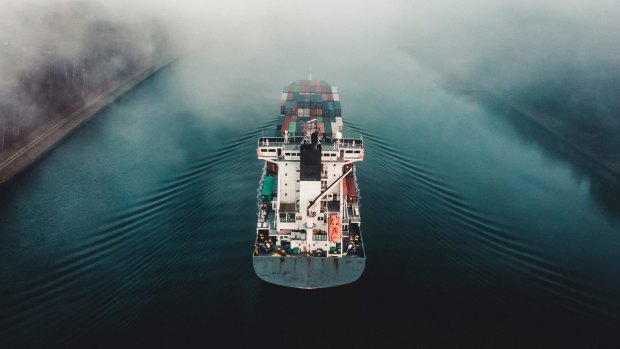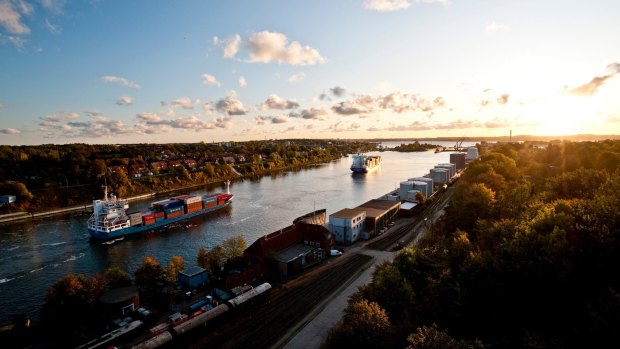This was published 4 years ago
Germany's Kiel Canal: The world's busiest man-made waterway is an engineer feat

Ship passes through the Kiel Canal, Germany.Credit: Getty Images
Petite canals enliven cities like Amsterdam, St Petersburg, Bruges and Venice but there's nothing quite like a big canal. These giant shipping channels sculpt the landscape, connecting oceans, separating continents and joining rivers.
Strategic canals like the Panama connecting Pacific and Atlantic, the Suez separating Africa from Asia, or the Corinth, dividing the Peloponnese from the Greek mainland appeal to the child in us. They recall tranquil beach days when, with bucket and spade, we engineered the geography of the sand, carving cities, channels and moats to temporarily corral the seawater.
For this canal lover, known to rise in the small hours to experience the hulking locks of the Rhine-Main-Danube Canal, which straddles the European watershed, Germany's Kiel Canal, adds another "big canal" experience to the list.

The picturesque Kiel canal. Credit: Getty Images
The Kiel is the world's busiest man-made waterway for seagoing ships, used by a similar number of ships as on the Panama and Suez canals combined.
Our Baltic Sea circumnavigation aboard APT's Hebridean Sky ends with a 4.30am arrival at Holtenau, on the Gulf of Kiel, in the virtually tideless south-western Baltic Sea. The 17-kilometre-long Kiel Fjord (not actually a fjord) funnels ships to the giant Holtenau locks at the easternmost entry to the Kiel Canal, delivering them to Brunsbuttel on the North Sea at the mouth of the River Elbe.
The canal slices through Schleswig-Holstein, Germany's northernmost state whose Baltic coast capital is Kiel, 90 kilometres north of Hamburg. This feat of engineering reduces the stormy 460-kilometre sail around the Jutland Peninsula - negotiating "the Sound" (Oresund Strait) and "the Belts" (the Danish straits) - to a 98-kilometre, eight-hour glide.
A ship from Dover to Kiel saves 682 kilometres and about 18 hours compared with the voyage via Skagen on Denmark's northern tip. And while the confluence of the North and Baltic seas at Skagen is a superb shape-shifting place of luminous light, the shipyard graveyards of those fallen victim to violent waters pointed to why seafarers have long sought to avoid the Jutland journey.
The Kiel Canal took more than 9000 workers eight years to build in 1887. Today, its banks harbour plump grazing cows, anglers trying their luck in the rain (more than 75 fish species inhabit the canal), cyclists, dog-walkers, canal-spotters, free car-ferry stations for 14 ferries, and wooded hillsides intersected by the occasional clutch of farmhouses, bridges and electricity transmission towers.
A shorter route between the Baltic and North seas long exercised the mind. It is believed the Vikings portaged ships on rollers across the 16-kilometre Kiel watershed to circumvent the dangerous Skagerrak and Kattegat.
Christian VII of Denmark built the first North Sea-Baltic link in 1784 - the Eider Canal, a miniature 43-kilometre canal by today's standards. It was part of a 175-kilometre waterway from Kiel to the Eider River mouth. The canal was only 29 metres wide and three metres deep. About 100 years later, the canal was deepened, widened and straightened.
Today's Kiel Canal, enlarged twice since 1887, is 160 metres wide and 11 metres deep. Seven high bridges cross it, allowing a 43-metre clearance, while the locks are 45 metres wide and 327 metres long.
Between 1907 and 1914, the Imperial German Navy ensured the canal and locks were widened and enlarged to allow passage of Dreadnought-sized battleships. The canal was originally going to be lock-free but wind-induced water level variations and tidal water variations, particularly in the North Sea and Elbe meant canal flow velocities were too high.
Along the Kiel Canal (formerly the Kaiser-Wilhelm-Kanal, now known in Germany as the Nord-Ostsee-Kanal), sidings regularly appear, a reminder that a strict code of sailing is enforced. This is where ships can moor to allow others to pass or where slow ships or towed conveys can be overtaken.
A pilot accompanies all boats, "traffic lights" instruct smaller vessels to proceed or tie up at the bollards to allow larger ships to pass. The locks accommodate a variety of vessels before regurgitating them.
The appearance of the high bridges ensures a frisson of onboard interest, particularly the Rendsburg High Bridge. It possesses an unusual engineering feature – this railway viaduct runs through a large 360-degree loop that crosses over itself so trains can descend to access nearby Rendsburg station.
Apart from the two sea entrances, the short Gieselau Canal links the canal at Oldenbuttel to the navigable Eider River.
The giant lock gates emerge from the mist at Brunsbuttel. We sail in slowly, idle, and then, like a cork from a champagne bottle, we pop out of the canal via the Elbe estuary into the North Sea to be greeted by bracing six-metre broadside swells for our sail into Amsterdam.
TRIP NOTES
FLY
Singapore Airlines flies daily from Sydney and Melbourne to Singapore and then Stockholm via Moscow and daily from London to Sydney and Melbourne. See singaporeair.com
CRUISE
APT's 13-day Best of the Baltics small ship cruise from Copenhagen to Stockholm starts from $14,995 a person twin share, departing July 2 and July 14, 2020. See aptouring.com.au
MORE
Sign up for the Traveller Deals newsletter
Get exclusive travel deals delivered straight to your inbox. Sign up now.